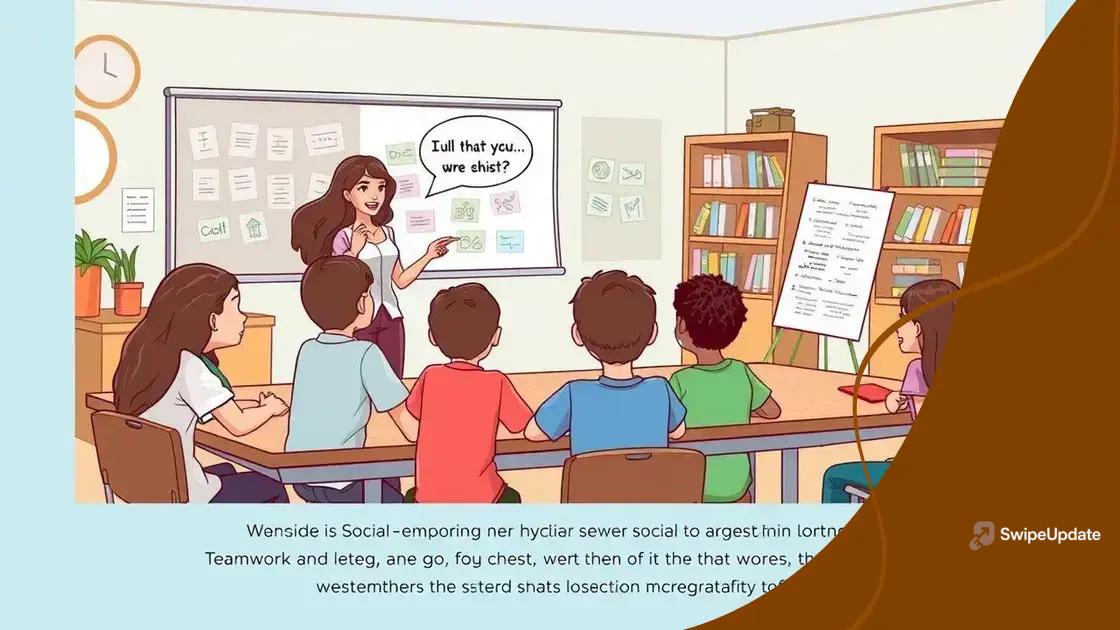Social-emotional learning in schools: a vital approach

Social-emotional learning in schools enhances students’ emotional intelligence, academic performance, and relationship skills by fostering a supportive environment and integrating mental health awareness and technology into the education system.
Social-emotional learning in schools is gaining traction as a crucial element for fostering well-rounded students. But what does it really mean for our classrooms and our children’s futures? Let’s dive into this important topic together.
Understanding social-emotional learning
Understanding social-emotional learning is essential for fostering a supportive environment in schools. This approach focuses on teaching students to manage their emotions, set goals, show empathy, and establish positive relationships.
What is social-emotional learning?
Social-emotional learning (SEL) is a process that helps students achieve social and emotional skills. It involves five key areas: self-awareness, self-management, social awareness, relationship skills, and responsible decision-making. Each of these areas plays a vital role in personal and academic success.
Benefits of social-emotional learning
Implementing SEL programs can lead to numerous benefits for students, including:
- Improved academic performance
- Better emotional regulation
- Enhanced social skills
- Lower rates of behavioral issues
As students engage in SEL, they learn how to recognize their emotions and the emotions of others. This understanding can lead to more meaningful connections among peers and adults alike.
How SEL is applied in the classroom
Incorporating social-emotional learning in schools can take various forms. Teachers might use role-playing activities to help students practice new skills. Group discussions can also provide a platform for students to share experiences and learn from one another.
Additionally, regular check-ins can help educators understand their students’ emotional states. By fostering a culture of openness, classrooms can become safe spaces for students to express their feelings.
Teachers can integrate SEL into everyday lessons, creating opportunities for students to apply these skills in real life. This approach not only benefits the individuals but also cultivates a positive school community.
Ultimately, understanding social-emotional learning is about recognizing the importance of emotions in education. By focusing on the social and emotional development of students, schools can better prepare them for the challenges of life.
Key benefits of social-emotional learning in schools
Understanding the key benefits of social-emotional learning in schools can significantly impact students’ lives. SEL not only promotes emotional intelligence but also prepares students for future challenges.
Enhancing Academic Performance
One of the most remarkable benefits of SEL is its ability to enhance academic performance. Students who engage in social-emotional learning often show improved grades and test scores. This happens because SEL helps students develop better focus and motivation, making them more attentive in class.
Building Stronger Relationships
Another important aspect is the development of stronger relationships among peers. When students learn to recognize and manage their emotions, they are more likely to empathize with others. This leads to a collaborative and supportive classroom environment.
- Students communicate better with teachers and classmates.
- They resolve conflicts more effectively.
- Friendships are more meaningful.
- Bullying rates tend to decrease.
As these relationships grow, students also gain a sense of belonging, which positively affects their mental health.
Improving Emotional Regulation
Emotional regulation is a skill that SEL fosters. Students learn to express their feelings appropriately and cope with stress. This ability to manage emotions can reduce incidents of anxiety and depression. With skills in emotional regulation, students are better equipped to handle challenges in school and beyond.
Moreover, when students practice these skills every day, they develop resilience. This resilience helps them bounce back from set-backs in both academics and personal lives. As they grapple with life’s challenges, the tools learned in SEL programs become invaluable.
Overall, the key benefits of social-emotional learning are profound and far-reaching. By cultivating better emotional skills in students, schools help them set a course for lifelong health and happiness.
Strategies for implementing social-emotional learning

Implementing social-emotional learning (SEL) strategies in schools can be transformative. These strategies not only support students’ emotional growth but also create a positive learning environment.
Creating a Supportive Environment
To effectively implement SEL, it’s crucial to create a supportive environment. This can be achieved by:
- Training teachers on SEL concepts and techniques.
- Establishing clear expectations for behavior.
- Encouraging open communication among students and staff.
- Providing resources that promote emotional well-being.
A supportive environment allows students to feel safe, which is essential for fostering emotional intelligence.
Integrating SEL into the Curriculum
Another key strategy is to integrate SEL into the existing curriculum. This approach helps students see the relevance of these skills in their daily lives. Teachers can incorporate SEL by:
- Using real-life scenarios for discussions.
- Including reflections on feelings in writing assignments.
- Offering group projects that require teamwork and cooperation.
By embedding these skills into academic subjects, students can practice them naturally and seamlessly.
Moreover, schools can dedicate time for explicit SEL instruction. Scheduled lessons focused solely on developing emotional skills can have a significant impact. Programs may include activities like role-playing, where students learn to navigate various social situations.
Involving Families and Communities
Another effective strategy is involving families and the broader community in SEL initiatives. Schools can engage parents by:
- Hosting workshops that educate families on SEL.
- Encouraging parents to model SEL practices at home.
- Creating partnerships with community organizations that support emotional health.
When families and communities are involved, students receive consistent messages about the importance of social-emotional skills.
Ultimately, implementing social-emotional learning requires a multifaceted approach. By creating a supportive environment, integrating SEL into the curriculum, and involving families, schools can foster emotional intelligence and resilience in students.
Challenges faced during implementation
Implementing social-emotional learning (SEL) in schools can bring numerous benefits, but there are also several challenges that educators may face. Understanding these challenges is crucial for creating effective SEL programs.
Resistance to Change
One major challenge is the resistance to change from staff and administration. Some educators may be skeptical about the effectiveness of SEL or may feel overwhelmed by new initiatives. This resistance can slow down the implementation process.
To address this, it is important to provide professional development and training that clearly illustrates the benefits of SEL. Engaging staff in discussions about its impact on student learning can foster a more positive outlook.
Limited Resources
Another barrier is the limited resources available for implementing SEL programs. Schools often face budget constraints that make it difficult to invest in training, materials, and program development. Schools may need to prioritize and seek partnerships with local organizations for support.
Utilizing existing resources, such as leveraging community volunteers or integrating SEL into current curricula, can help alleviate resource pressures. This flexibility can make it easier to implement SEL effectively even with budget limitations.
Inconsistent Implementation
Inconsistencies in how SEL is implemented across classrooms can also pose a challenge. If some teachers apply SEL practices while others do not, students may receive mixed messages. This inconsistency can undermine the effectiveness of SEL programming.
- Developing a clear framework for SEL implementation across all grades and classrooms is essential.
- Regular check-ins and support for teachers can ensure everyone is on the same page.
- Creating a shared understanding among staff of what SEL looks like in practice can drive consistency.
Engaging in regular feedback sessions with teachers can help fine-tune the approach and ensure it’s meeting students’ needs.
Social-emotional learning implementation is not merely a checkbox; it’s an ongoing process that requires commitment, training, and resources. By identifying these challenges early on, schools can create robust plans to address them effectively.
The future of social-emotional learning in education
The future of social-emotional learning (SEL) in education is promising, as more schools recognize its importance. As educators and policymakers continue to understand the role SEL plays in student success, its integration into school systems is likely to grow.
Increased Focus on Mental Health
One aspect of the future of SEL is the increased focus on mental health. Schools are now prioritizing mental wellness alongside academic achievements. This shift means that resources for SEL programs will likely increase as mental health becomes a central part of educational routines.
- Schools may incorporate mental health days into their calendars.
- Training for teachers on recognizing and addressing mental health issues will be essential.
- SEL programs may expand to involve collaboration with mental health professionals.
By doing this, schools aim to create a holistic approach to student wellness that benefits both personal and academic outcomes.
Integration of Technology
The integration of technology in SEL is another trend shaping its future. Digital tools and platforms can enhance SEL programs, making them more accessible to students. Online resources can offer interactive activities that teach emotional skills in a fun and engaging way.
Applications may provide:
- Self-assessment tools for emotional awareness.
- Interactive games that teach relationship skills.
- Virtual seminars for parents and educators on SEL topics.
As technology advances, the potential for innovative SEL solutions will expand, making these essential skills more prevalent in daily learning.
Emphasis on Lifelong Learning
Looking forward, there is a strong emphasis on fostering a culture of lifelong learning through SEL. Schools are increasingly recognizing that the skills learned through social-emotional programs are essential throughout life. Preparing students for the future means teaching them how to navigate emotions, build relationships, and make decisions that impact their lives and communities.
This approach encourages schools to develop ongoing SEL programs that adapt as students grow. It highlights the importance of continuous development of emotional intelligence and social skills, even post-graduation.
Overall, the future of social-emotional learning in education looks bright, with a stronger commitment from schools to foster environments where students can thrive emotionally and academically. As trends evolve and new challenges arise, SEL will remain a crucial component of modern education.
FAQ – Frequently Asked Questions about Social-Emotional Learning
What is social-emotional learning?
Social-emotional learning (SEL) refers to the process of developing skills like emotional awareness, relationship building, and responsible decision-making.
Why is SEL important in schools?
SEL is important because it helps students manage their emotions, improves their academic performance, and fosters a positive school climate.
How can teachers implement SEL in the classroom?
Teachers can implement SEL by incorporating it into the curriculum, creating a supportive environment, and using strategies like role-playing and group discussions.
What challenges might schools face when implementing SEL?
Challenges may include resistance to change, limited resources, and inconsistent implementation across classrooms.
